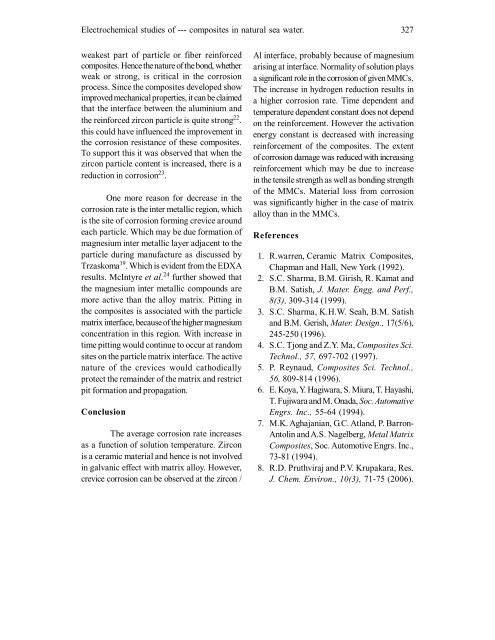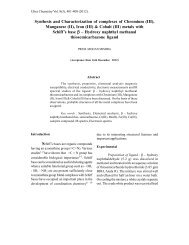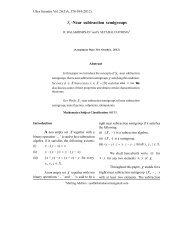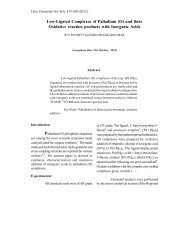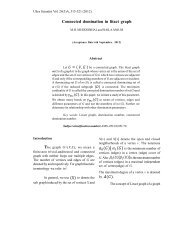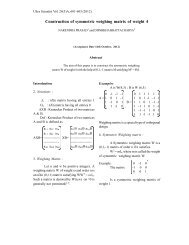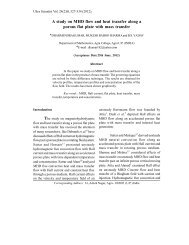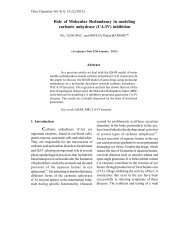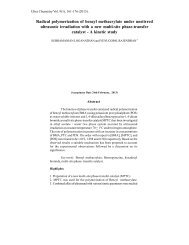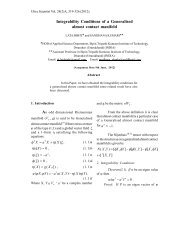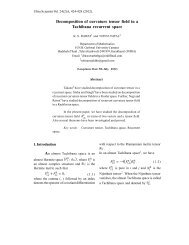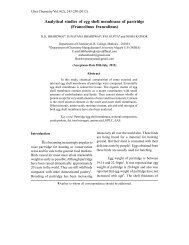Electrochemical studies of Al 7075/zircon metal ... - Ultrascientist.org
Electrochemical studies of Al 7075/zircon metal ... - Ultrascientist.org
Electrochemical studies of Al 7075/zircon metal ... - Ultrascientist.org
Create successful ePaper yourself
Turn your PDF publications into a flip-book with our unique Google optimized e-Paper software.
<strong>Electrochemical</strong> <strong>studies</strong> <strong>of</strong> --- composites in natural sea water. 327weakest part <strong>of</strong> particle or fiber reinforcedcomposites. Hence the nature <strong>of</strong> the bond, whetherweak or strong, is critical in the corrosionprocess. Since the composites developed showimproved mechanical properties, it can be claimedthat the interface between the aluminium andthe reinforced <strong>zircon</strong> particle is quite strong 22 .this could have influenced the improvement inthe corrosion resistance <strong>of</strong> these composites.To support this it was observed that when the<strong>zircon</strong> particle content is increased, there is areduction in corrosion 23 .One more reason for decrease in thecorrosion rate is the inter <strong>metal</strong>lic region, whichis the site <strong>of</strong> corrosion forming crevice aroundeach particle. Which may be due formation <strong>of</strong>magnesium inter <strong>metal</strong>lic layer adjacent to theparticle during manufacture as discussed byTrzaskoma 19 . Which is evident from the EDXAresults. McIntyre et al. 24 further showed thatthe magnesium inter <strong>metal</strong>lic compounds aremore active than the alloy matrix. Pitting inthe composites is associated with the particlematrix interface, because <strong>of</strong> the higher magnesiumconcentration in this region. With increase intime pitting would continue to occur at randomsites on the particle matrix interface. The activenature <strong>of</strong> the crevices would cathodicallyprotect the remainder <strong>of</strong> the matrix and restrictpit formation and propagation.ConclusionThe average corrosion rate increasesas a function <strong>of</strong> solution temperature. Zirconis a ceramic material and hence is not involvedin galvanic effect with matrix alloy. However,crevice corrosion can be observed at the <strong>zircon</strong> /<strong>Al</strong> interface, probably because <strong>of</strong> magnesiumarising at interface. Normality <strong>of</strong> solution playsa significant role in the corrosion <strong>of</strong> given MMCs.The increase in hydrogen reduction results ina higher corrosion rate. Time dependent andtemperature dependent constant does not dependon the reinforcement. However the activationenergy constant is decreased with increasingreinforcement <strong>of</strong> the composites. The extent<strong>of</strong> corrosion damage was reduced with increasingreinforcement which may be due to increasein the tensile strength as well as bonding strength<strong>of</strong> the MMCs. Material loss from corrosionwas significantly higher in the case <strong>of</strong> matrixalloy than in the MMCs.References1. R.warren, Ceramic Matrix Composites,Chapman and Hall, New York (1992).2. S.C. Sharma, B.M. Girish, R. Kamat andB.M. Satish, J. Mater. Engg. and Perf.,8(3), 309-314 (1999).3. S.C. Sharma, K.H.W. Seah, B.M. Satishand B.M. Gerish, Mater. Design., 17(5/6),245-250 (1996).4. S.C. Tjong and Z.Y. Ma, Composites Sci.Technol., 57, 697-702 (1997).5. P. Reynaud, Composites Sci. Technol.,56, 809-814 (1996).6. E. Koya, Y. Hagiwara, S. Miura, T. Hayashi,T. Fujiwara and M. Onada, Soc. AutomativeEngrs. Inc., 55-64 (1994).7. M.K. Aghajanian, G.C. Atland, P. Barron-Antolin and A.S. Nagelberg, Metal MatrixComposites, Soc. Automotive Engrs. Inc.,73-81 (1994).8. R.D. Pruthviraj and P.V. Krupakara, Res.J. Chem. Environ., 10(3), 71-75 (2006).


